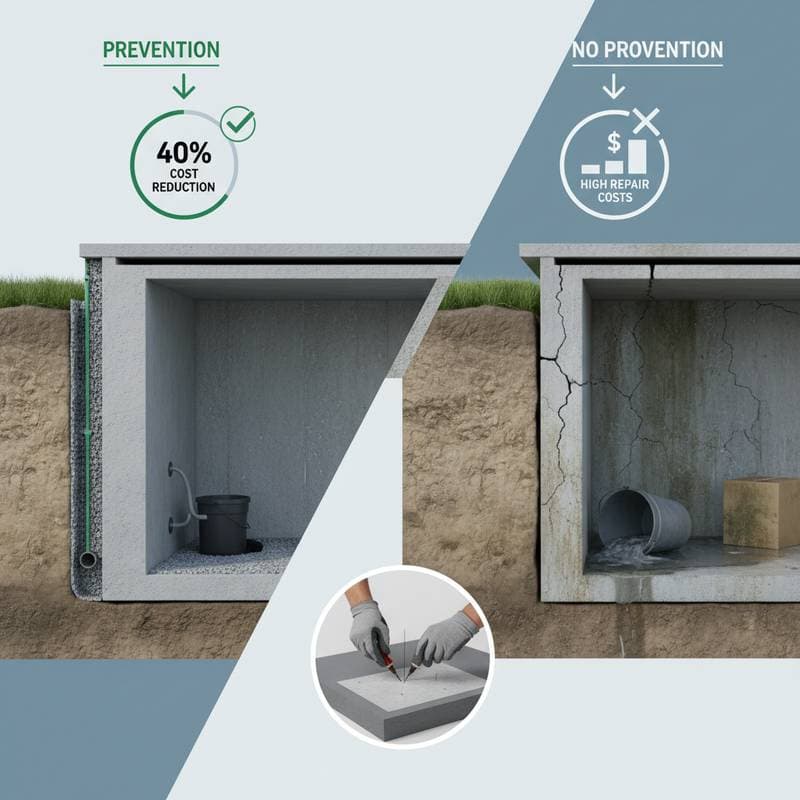Complete Basement Waterproofing: 2025 Costs and Prevention Strategies
A dry basement supports the structural integrity of the home, improves indoor air quality, and preserves property value. Water infiltration through walls or floors compromises the foundation, fosters mold growth, and elevates humidity throughout the residence. Effective basement waterproofing addresses these risks and enables homeowners to sustain a comfortable and secure living environment.
This guide covers the essential aspects of basement waterproofing, including underlying causes, early warning indicators, preventive measures, and detailed cost analyses. It provides practical steps recommended by experts to achieve durable outcomes.
Identifying Signs of Water Intrusion
Homeowners should monitor for these indicators to address potential issues before they escalate.
- Persistent damp or musty odors. Such smells arise from moisture trapped within walls or floors, signaling ongoing evaporation.
- Efflorescence on surfaces. This white, powdery deposit forms as water evaporates, leaving behind dissolved minerals from concrete or masonry.
- Peeling paint or rust stains. Moisture penetration disrupts surface finishes, causing paint to blister and metal elements to corrode.
- Cracks in walls or floors. Even minor fissures permit groundwater to seep inward, potentially widening over time.
- Water accumulation after rainfall. Visible puddles in the basement highlight inadequate exterior drainage around the foundation perimeter.
Prompt attention to these signs prevents the need for extensive repairs. Early intervention for a minor leak typically incurs costs far below those of comprehensive foundation restoration, often saving up to 90 percent in expenses.
Detailed Cost Analysis for Waterproofing Options
Costs fluctuate based on the extent of the issue, selected materials, and required labor. The following table outlines typical ranges for prevalent waterproofing techniques.
| Method | Average Cost Range | Description |
|---|---|---|
| Interior Sealant Application | $1,500–$5,000 | Suitable for minor leaks and surface dampness; involves coating walls and floors with waterproof membranes. |
| Interior Drainage System with Sump Pump | $4,000–$10,000 | Provides a reliable solution for persistent water entry; channels moisture to a pump for ejection outside. |
| Exterior Waterproofing Membrane | $8,000–$20,000 | Offers comprehensive protection; requires excavation to apply barriers and drainage boards against foundation walls. |
| French Drain Installation | $2,000–$6,000 | Redirects surface and subsurface water away from the foundation; ideal for managing runoff in sloped yards. |
Recommended Visualization: Include a bar graph illustrating cost ranges alongside projected lifespans for each method, titled Basement Waterproofing Options: Costs vs. Durability.
Combining approaches often yields optimal protection. For instance, applying an interior sealant alongside an exterior drainage system reinforces defenses against water intrusion. Such integrated strategies prolong foundation stability and minimize ongoing upkeep requirements.
To maximize savings, prioritize preventive actions like grading soil away from the foundation and installing gutter extensions. These measures can reduce the scope of waterproofing projects by up to 40 percent, avoiding the need for invasive repairs.
Addressing Key Concerns in Basement Waterproofing
Expected Durability of Waterproofing Solutions
Interior sealants maintain effectiveness for 10 to 15 years when the area remains free of debris and excess moisture. Exterior membranes, when properly installed and shielded from shifting soil, endure 20 to 50 years or more, depending on material quality and site conditions.
Comparing Interior and Exterior Approaches
Exterior methods provide superior long-term barriers but demand significant site access for excavation. Interior systems prove more feasible for properties with restricted outdoor space or in urban settings. Selection hinges on water source analysis—surface runoff favors exterior solutions, while hydrostatic pressure suits interior drainage.
Feasibility of DIY Waterproofing Efforts
Homeowners can manage basic tasks, such as applying epoxy-based sealants to small cracks or regrading soil for better drainage. However, projects involving substantial fissures, frequent flooding, or foundation shifts necessitate professional evaluation to ensure structural safety and code compliance.
Impact on Property Valuation
Documented waterproofing enhancements boost buyer appeal by demonstrating proactive maintenance. A functional, moisture-free basement expands usable square footage for recreation, storage, or additional living areas, potentially increasing resale value by 5 to 10 percent.
Case Study: Resolving Recurrent Water Issues
One homeowner observed discolored stains along baseboards following intense storms. Inspection revealed overloaded gutters channeling water directly toward the foundation walls. The contractor recommended a multifaceted remedy: thorough gutter cleaning, extension of downspouts by 10 feet, injection of polyurethane sealant into identified cracks, and burial of a perimeter French drain.
Post-implementation, the basement remained free of moisture during multiple subsequent rain events. This example illustrates the efficacy of targeted interventions. By tackling both ingress points and drainage pathways, homeowners secure robust, layered protection without resorting to full-scale overhauls.
Implementing and Maintaining Waterproofing Measures
Basement waterproofing represents a strategic investment in residential longevity and occupant well-being. Early detection of moisture sources, paired with appropriate interventions, averts foundation deterioration and supports consistent indoor air quality.
Begin with foundational prevention: ensure soil slopes at least 6 inches downward over a 10-foot distance from the house, schedule biannual gutter cleanings, and apply annual sealant touch-ups to vulnerable surfaces. For persistent challenges, engage certified contractors to tailor solutions to specific soil types, climate factors, and budget constraints.
Ultimately, a waterproofed basement delivers tranquility, healthier living conditions, and enhanced marketability. Each prevented infiltration contributes to the home's enduring resilience from foundation to roofline.





